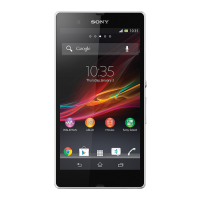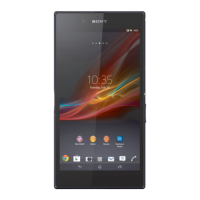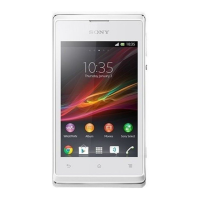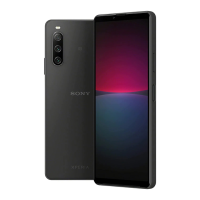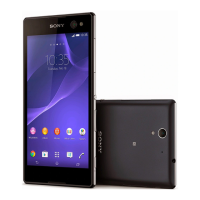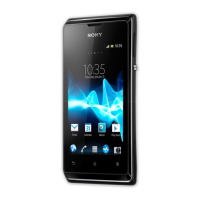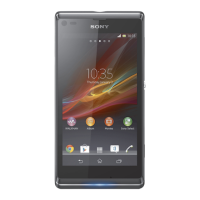Do you have a question about the Sony C6603 and is the answer not in the manual?
Identifies and labels the external components of the device.
Step-by-step guide for inserting the micro SIM and memory cards.
Guidance on removing screen film and recommended protection.
Information on the initial setup guide and turning on the device.
Explains the benefits and necessity of a Google account for device usage.
Instructions on how to charge the device and battery care advice.
Explains basic touch gestures like tapping and touching and holding.
How the screen locks automatically and basic swipe unlock.
Introduction to the device's home screen and its panes.
Overview of the application screen and how to navigate it.
Explains navigation using keys, favourites bar, and recent apps.
Information on miniature apps for multitasking.
Using widgets on the Home screen and managing shortcuts/folders.
Tracking battery consumption and optimizing performance.
Details on STAMINA, Low-battery, and Queue background data modes.
How notifications appear and how to manage them.
Explanation of various status icons displayed on the device.
How to download apps from Google Play and other sources.
Browsing the web using Google Chrome™.
Connecting to Wi-Fi networks and managing settings.
Sharing data via USB tethering, Bluetooth, or Wi-Fi hotspot.
Tracking and managing mobile and Wi-Fi data consumption.
Adjusting device volume, ringtones, and silent mode settings.
Locking/unlocking the SIM card and changing PIN.
Adjusting brightness, vibration on touch, and idle time.
Different screen lock types and security levels.
Using Smart Lock to unlock the device in certain situations.
Pairing and connecting trusted Bluetooth devices.
Using trusted locations to keep the device unlocked.
Changing the device's display language and input language.
Setting the device's date, time, and time zone.
Details on QWERTY, gesture, and one-handed keyboard use.
Using voice commands for text input.
Customizing keyboard settings, languages, and suggestions.
Making calls manually, using smart dial, and international calls.
How to answer, reject, or mute incoming calls.
Directing calls and blocking incoming/outgoing calls.
Transferring contacts via computer or online accounts.
Detailed steps for adding and editing contact information.
Entering ICE information for emergencies.
Exporting contacts to memory card, SIM card, or USB storage.
How to read, compose, and send text and multimedia messages.
Using Google Hangouts for chat and video calls.
Instructions for configuring email accounts on the device.
Sorting and managing emails within the inbox.
Methods to copy music files from a computer.
Navigating the music player interface and managing songs.
Creating, playing, and managing music playlists.
Identifying songs playing in the surroundings using TrackID.
Taking photos and recording videos with the device camera.
Using face detection and Smile Shutter for optimal photos.
Turning on geotagging to add location data to photos.
Adjusting resolution, self-timer, and other still camera settings.
Adjusting video settings like resolution and scene selection.
Selecting video resolution formats like Full HD, HD, VGA, and MMS.
Steps to open and browse photos and videos.
Sharing, editing, and organizing media files.
Applying effects and editing photos using the Photo editor.
Hiding media files from the Album home screen.
Viewing geotagged photos on a map or globe.
Steps to play videos within the Video application.
Getting video info, clearing data, and deleting videos.
Displaying the device screen on a TV using a cable.
Viewing media on DLNA devices over a network.
Connecting USB devices like storage, keyboards via USB Host adapter.
Using Near Field Communications for data sharing and tag scanning.
Using Bluetooth for file transfer and connecting accessories.
Using Smart Connect to control accessories and settings.
Making payments using the device via NFC.
Enabling location services for apps like Maps and Camera.
Activating data roaming for internet access abroad.
Using the Calendar app to manage time and events.
Setting and managing alarms, world clock, and stopwatch.
Enabling zoom by tapping the screen multiple times.
Increasing the default text size for better readability.
Screen reader for visually impaired users providing spoken feedback.
Methods to update device software wirelessly or via computer.
Using 'Protection by my Xperia' to locate and secure a lost device.
Tips to optimize device memory and storage.
Using Xperia™ Companion to back up data to a PC or Mac.
Forcing restarts and performing factory data resets.
Identifies and labels the external components of the device.
Step-by-step guide for inserting the micro SIM and memory cards.
Guidance on removing screen film and recommended protection.
Information on the initial setup guide and turning on the device.
Explains the benefits and necessity of a Google account for device usage.
Instructions on how to charge the device and battery care advice.
Explains basic touch gestures like tapping and touching and holding.
How the screen locks automatically and basic swipe unlock.
Introduction to the device's home screen and its panes.
Overview of the application screen and how to navigate it.
Explains navigation using keys, favourites bar, and recent apps.
Information on miniature apps for multitasking.
Using widgets on the Home screen and managing shortcuts/folders.
Tracking battery consumption and optimizing performance.
Details on STAMINA, Low-battery, and Queue background data modes.
How notifications appear and how to manage them.
Explanation of various status icons displayed on the device.
How to download apps from Google Play and other sources.
Browsing the web using Google Chrome™.
Connecting to Wi-Fi networks and managing settings.
Sharing data via USB tethering, Bluetooth, or Wi-Fi hotspot.
Tracking and managing mobile and Wi-Fi data consumption.
Adjusting device volume, ringtones, and silent mode settings.
Locking/unlocking the SIM card and changing PIN.
Adjusting brightness, vibration on touch, and idle time.
Different screen lock types and security levels.
Using Smart Lock to unlock the device in certain situations.
Pairing and connecting trusted Bluetooth devices.
Using trusted locations to keep the device unlocked.
Changing the device's display language and input language.
Setting the device's date, time, and time zone.
Details on QWERTY, gesture, and one-handed keyboard use.
Using voice commands for text input.
Customizing keyboard settings, languages, and suggestions.
Making calls manually, using smart dial, and international calls.
How to answer, reject, or mute incoming calls.
Directing calls and blocking incoming/outgoing calls.
Transferring contacts via computer or online accounts.
Detailed steps for adding and editing contact information.
Entering ICE information for emergencies.
Exporting contacts to memory card, SIM card, or USB storage.
How to read, compose, and send text and multimedia messages.
Using Google Hangouts for chat and video calls.
Instructions for configuring email accounts on the device.
Sorting and managing emails within the inbox.
Methods to copy music files from a computer.
Navigating the music player interface and managing songs.
Creating, playing, and managing music playlists.
Identifying songs playing in the surroundings using TrackID.
Taking photos and recording videos with the device camera.
Using face detection and Smile Shutter for optimal photos.
Turning on geotagging to add location data to photos.
Adjusting resolution, self-timer, and other still camera settings.
Adjusting video settings like resolution and scene selection.
Selecting video resolution formats like Full HD, HD, VGA, and MMS.
Steps to open and browse photos and videos.
Sharing, editing, and organizing media files.
Applying effects and editing photos using the Photo editor.
Hiding media files from the Album home screen.
Viewing geotagged photos on a map or globe.
Steps to play videos within the Video application.
Getting video info, clearing data, and deleting videos.
Displaying the device screen on a TV using a cable.
Viewing media on DLNA devices over a network.
Connecting USB devices like storage, keyboards via USB Host adapter.
Using Near Field Communications for data sharing and tag scanning.
Using Bluetooth for file transfer and connecting accessories.
Using Smart Connect to control accessories and settings.
Making payments using the device via NFC.
Enabling location services for apps like Maps and Camera.
Activating data roaming for internet access abroad.
Using the Calendar app to manage time and events.
Setting and managing alarms, world clock, and stopwatch.
Enabling zoom by tapping the screen multiple times.
Increasing the default text size for better readability.
Screen reader for visually impaired users providing spoken feedback.
Methods to update device software wirelessly or via computer.
Using 'Protection by my Xperia' to locate and secure a lost device.
Tips to optimize device memory and storage.
Using Xperia™ Companion to back up data to a PC or Mac.
Forcing restarts and performing factory data resets.
| Model | C6603 |
|---|---|
| Brand | Sony |
| Release Date | February 2013 |
| Display Type | TFT |
| Display Size | 5.0 inches |
| Display Resolution | 1080 x 1920 pixels |
| Operating System | Android 4.1.2 (Jelly Bean), upgradable to 5.1.1 (Lollipop) |
| Chipset | Qualcomm APQ8064 Snapdragon S4 Pro |
| CPU | Quad-core 1.5 GHz Krait |
| GPU | Adreno 320 |
| RAM | 2 GB |
| Internal Storage | 16 GB |
| Front Camera | 2.2 MP |
| Network | GSM / HSPA / LTE |
| SIM | Micro-SIM |
| WLAN | Wi-Fi 802.11 a/b/g/n, dual-band, Wi-Fi Direct, DLNA, hotspot |
| Bluetooth | 4.0, A2DP |
| GPS | Yes, with A-GPS, GLONASS |
| NFC | Yes |
| Radio | Stereo FM radio, RDS |
| USB | microUSB 2.0 (MHL TV-out) |
| Sensors | Accelerometer, gyro, proximity, compass |
| Colors | Black, White, Purple |
| Weight | 146 g |
| External Storage | microSD, up to 32GB |
| Main Camera | 13 MP, f/2.4, AF |
| Battery | Li-Ion 2330 mAh, non-removable |
| Dimensions | 139 x 71 x 7.9 mm |
